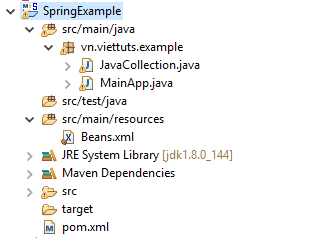Injecting Collection trong Spring
Previous Như bạn đã thấy cách cấu hình kiểu dữ liệu nguyên thủy bằng cách sử dụng thuộc tính value và tham chiếu đối tượng bằng cách sử dụng thuộc tính ref của thẻ <property> trong file cấu hình Bean. Spring cung cấp 4 loại phần tử để cấu hình các đối tượng ...
Như bạn đã thấy cách cấu hình kiểu dữ liệu nguyên thủy bằng cách sử dụng thuộc tính value và tham chiếu đối tượng bằng cách sử dụng thuộc tính ref của thẻ <property> trong file cấu hình Bean.
Spring cung cấp 4 loại phần tử để cấu hình các đối tượng Collection:
| No. | Phần tử & Mô tả |
|---|---|
| 1 |
<list> Phần tử này giúp tiêm một danh sách các giá trị cho đối tượng List, cho phép trùng lặp. |
| 2 |
<set> Phần tử này giúp tiêm một danh sách các giá trị cho đối tượng Set, KHÔNG cho phép trùng lặp. |
| 3 |
<map> Phần tử này giúp tiêm một tập hợp các cặp tên-giá trị trong đó tên và giá trị có thể thuộc bất kỳ kiểu dữ liệu nào. |
| 4 |
<props> một tập hợp các cặp tên-giá trị trong đó tên và giá trị đều là String |
Cũng giống như các đối tượng khác trong Spring, bạn có thể truyền giá trị cho đối tượng Collection bằng 2 cách:
- Sử dụng thuộc tính value, truyền giá trị trực tiếp cho đối tượng Collection.
- Sử dụng thuộc tính ref, tham chiếu tới một bean khác.
Ví dụ Injecting Collection trong Spring
Tạo một Java Maven project trong Eclipse.
Cấu trúc project:

Sau đó update file pom.xml để tải thư viện Spring như sau:
<project xmlns="http://maven.apache.org/POM/4.0.0"
xmlns:xsi="http://www.w3.org/2001/XMLSchema-instance"
xsi:schemaLocation="http://maven.apache.org/POM/4.0.0
http://maven.apache.org/xsd/maven-4.0.0.xsd">
<modelVersion>4.0.0</modelVersion>
<groupId>vn.viettuts</groupId>
<artifactId>SpringExample</artifactId>
<version>0.0.1-SNAPSHOT</version>
<packaging>jar</packaging>
<name>SpringExample</name>
<url>http://maven.apache.org</url>
<properties>
<project.build.sourceEncoding>UTF-8</project.build.sourceEncoding>
</properties>
<dependencies>
<dependency>
<groupId>org.springframework</groupId>
<artifactId>spring-core</artifactId>
<version>4.3.6.RELEASE</version>
<scope>provided</scope>
</dependency>
<dependency>
<groupId>org.springframework</groupId>
<artifactId>spring-beans</artifactId>
<version>4.3.6.RELEASE</version>
</dependency>
<dependency>
<groupId>org.springframework</groupId>
<artifactId>spring-context</artifactId>
<version>4.3.6.RELEASE</version>
</dependency>
</dependencies>
</project>
Đây là nội dung của file JavaCollection.java
package vn.viettuts.example;
import java.util.List;
import java.util.Map;
import java.util.Properties;
import java.util.Set;
public class JavaCollection {
private List addressList;
private Set addressSet;
private Map addressMap;
Properties addressProp;
public void setAddressList(List addressList) {
this.addressList = addressList;
}
public List getAddressList() {
System.out.println("List Elements :" + addressList);
return addressList;
}
public void setAddressSet(Set addressSet) {
this.addressSet = addressSet;
}
public Set getAddressSet() {
System.out.println("Set Elements :" + addressSet);
return addressSet;
}
public void setAddressMap(Map addressMap) {
this.addressMap = addressMap;
}
public Map getAddressMap() {
System.out.println("Map Elements :" + addressMap);
return addressMap;
}
public void setAddressProp(Properties addressProp) {
this.addressProp = addressProp;
}
public Properties getAddressProp() {
System.out.println("Property Elements :" + addressProp);
return addressProp;
}
}
Đây là nội dung của file MainApp.java
package vn.viettuts.example;
import org.springframework.context.ApplicationContext;
import org.springframework.context.support.ClassPathXmlApplicationContext;
/**
* Hello world!
*
*/
public class MainApp {
public static void main(String[] args) {
ApplicationContext context = new ClassPathXmlApplicationContext(
"Beans.xml");
JavaCollection jc = (JavaCollection) context.getBean("javaCollection");
jc.getAddressList();
jc.getAddressSet();
jc.getAddressMap();
jc.getAddressProp();
}
}
Sau đây là tệp cấu hình Beans.xml có cấu hình cho tất cả các đối tượng Collection:
<?xml version="1.0" encoding="UTF-8"?>
<beans xmlns="http://www.springframework.org/schema/beans"
xmlns:xsi="http://www.w3.org/2001/XMLSchema-instance"
xsi:schemaLocation="http://www.springframework.org/schema/beans
http://www.springframework.org/schema/beans/spring-beans-3.0.xsd">
<bean id = "javaCollection" class = "vn.viettuts.example.JavaCollection">
<property name = "addressList">
<list>
<value>Ha Noi</value>
<value>Vinh Phuc</value>
<value>Bac Ninh</value>
</list>
</property>
<property name = "addressSet">
<set>
<value>Ha Noi</value>
<value>Vinh Phuc</value>
<value>Bac Ninh</value>
</set>
</property>
<property name = "addressMap">
<map>
<entry key = "1" value = "Ha Noi"/>
<entry key = "2" value = "Vinh Phuc"/>
<entry key = "3" value = "Bac Ninh"/>
</map>
</property>
<property name = "addressProp">
<props>
<prop key = "one">Ha Noi</prop>
<prop key = "one">Ha Noi</prop>
<prop key = "two">Vinh Phuc</prop>
<prop key = "three">Bac Ninh</prop>
</props>
</property>
</bean>
</beans>
Injecting Bean tham chiếu
Định nghĩa Bean sau đây sẽ giúp bạn hiểu cách chèn các bean tham chiếu như một phần tử của đối tượng Collection. Thậm chí bạn có thể kết hợp tất cả tham chiếu và giá trị với nhau.
?xml version = "1.0" encoding = "UTF-8"?>
<beans xmlns = "http://www.springframework.org/schema/beans"
xmlns:xsi = "http://www.w3.org/2001/XMLSchema-instance"
xsi:schemaLocation = "http://www.springframework.org/schema/beans
http://www.springframework.org/schema/beans/spring-beans-3.0.xsd">
<bean id = "..." class = "...">
<property name = "addressList">
<list>
<ref bean = "address1"/>
<ref bean = "address2"/>
<value>Pakistan</value>
</list>
</property>
<property name = "addressSet">
<set>
<ref bean = "address1"/>
<ref bean = "address2"/>
<value>Pakistan</value>
</set>
</property>
<property name = "addressMap">
<map>
<entry key = "one" value = "INDIA"/>
<entry key = "two" value-ref = "address1"/>
<entry key = "three" value-ref = "address2"/>
</map>
</property>
</bean>
</beans>
Kết quả:
List Elements :[Ha Noi, Vinh Phuc, Bac Ninh]
Set Elements :[Ha Noi, Vinh Phuc, Bac Ninh]
Map Elements :{1=Ha Noi, 2=Vinh Phuc, 3=Bac Ninh}
Property Elements :{two=Vinh Phuc, one=Ha Noi, three=Bac Ninh}
Injecting giá trị rỗng và giá trị null
Nếu bạn cần truyền một chuỗi rỗng dưới dạng một giá trị, thì bạn có thể truyền nó như sau:
<bean id = "..." class = "exampleBean"> <property name = "email" value = ""/> </bean>
Ví dụ trước tương đương với mã Java: exampleBean.setEmail(“”)
Nếu bạn cần truyền một giá trị NULL, thì bạn có thể truyền nó như sau:
<bean id = "..." class = "exampleBean"> <property name = "email"><null/></property> </bean>
Ví dụ trước tương đương với mã Java: exampleBean.setEmail(null)
